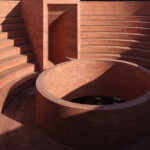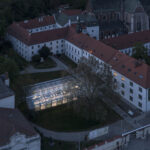Author’s Note: The author and editor of this piece spent a long time discussing whether or not it should be published. We were both concerned about the ethics of giving attention to Ye, an artist of inarguable gifts, but one who has in recent years used his platform to spread bigotry and hatred. We decided to go with it, if only because the story recounted here helps puncture the myth of Ye’s genius — a reputation he has systematically cultivated for decades, frequently comparing himself to figures such as Einstein, Shakespeare, and Picasso. As this article shows, there is nothing visionary about his recent foray into architecture.
The New Yorker recently published a gripping article by Ian Parker titled “Kanye West Bought an Architectural Treasure — then Gave it a Violent Remix.” The piece really is riveting, the type of story that would have attracted Tom Wolfe — or maybe J.G. Ballard. Like a fiery car crash, one simply cannot turn away from it.
For those who haven’t read the article, the news angle is that Ye is being sued by a contractor named Tony Saxon. In the lawsuit, Saxon describes the surreal experience of being hired by Ye to renovate a house that he purchased in Malibu for $57 million in the fall of 2021. Instead of having Saxon perform routine renovations, Ye asked him to dismantle the house piece by piece for reasons that were never altogether clear. This all happened around a year before the once universally feted musician would torch his reputation by appearing on the notorious far-right television program InfoWars and proclaiming that he “loved Hitler.”
When Ye made this comment, it did not come as a surprise. In the months leading up to the InfoWars appearance, Ye had made numerous antisemitic comments on social media and in interviews, which had already led to the dissolution of his business partnerships with Adidas, Balenciaga, and other brands, cratering his net worth
To return to Ballard, there was something sickeningly compelling about this two-month stretch in Ye’s career. Putting aside the potentially mitigating factor of the artist’s mental illness — a very controversial topic — the performance seemed intentional, a perverse act of destruction aimed not only at himself but, unforgivably, innocent others. One could speculate as to why he did it, but in the end it doesn’t matter. By aligning himself with Hitler, Ye revealed not only his own personal bigotry, but the totalitarian cast of his mind. To those who had been following his career, it made a lot of sense.
As an artist, Ye is fascinated with the idea of creating controlled environments and experiences. His drift toward right wing politics is simply the extension of this impulse into the realm of society. As most artists intuitively know, this is the red line, and the point where Ye’s provocations stop being interesting and become dangerous.
Architecture is unique because it is both an art form and type of social infrastructure. Knowing how Ye thinks and works, one could predict that architecure would be a bad fit for him, an area where his transgressive impulses would manifest as pure negativity and destructiveness. And according to Saxon’s account, this is exactly what happened.
The house that Ye hired Saxon to work on was not just any Malibu mansion, but a minimalist masterpiece designed by the Pritzker Prize winning Japanese architect Tadao Ando, one of only a handful of Ando residences in North America.
Among living architects, Ando’s reputation is singular. As Architizer’s resident Brutalism defender, I count myself as a big fan. Ando’s ability to evoke an intimate sense of place with the fewest possible elements is evident even in photographs. This isn’t really Brutalism; it is concrete architecture that ennobles the industrial materials that go into its construction and even suggests a new way of inhabiting space, both public and private. One that is careful, conscientious and mindful.
The idea of gut renovating an Ando house and deviating from the architect’s vision is itself risible. Why buy an Ando in order to disturb the architect’s delicate vision? A comparable house designed by someone else would not have cost nearly as much and no one would have cared what Ye did with it. But here is the issue. What Ye had in mind was not a renovation at all. He intended something else — desecration.
When Saxon was first led through the house by the architect Bianca Censori — now Ye’s wife — he saw that it was not only beautiful, but functional as a living space. While empty of furnishings, the house had bathrooms lined in “gorgeous black-and-white marble, like something in a New York hotel in the nineteen-twenties.” The wooden cabinetry also made an impression on Saxon, who estimated that its installation would have cost hundreds of thousands of dollars. Dramatic design elements such as sweeping ocean views and oversized staircases coexisted alongside pedestrian elements such as a laundry room that housed the controls for the home’s heating and cooling system. Although designed by a living legend, this was not a sculpture or temple; it was a house.
Ye ordered Saxon to destroy everything that made the house functional, including all the pipes, the windows, and the electricity. He also wanted to replace the wide staircases — an Ando trademark — with ramps of some kind. He apparently has expressed interest in “outlawing” staircases in the past, but not out of any concern for accessibility.
As Parker explains, “The ramps that Ye proposed for Malibu Road appeared to be at least four times as steep as any allowed by the Americans with Disabilities Act, and they would have ended not far from the edge of a terrace that, during the demolition process, lost its balustrade. Someone descending the ramp from the primary bedroom on, say, a skateboard, could expect to shoot off the edge and land some thirty feet below, on the beach.”
Saxon followed Ye’s deranged instructions, working discreetly without permits to dismantle the house piece by piece. While the suicide ramps were thankfully never installed, the house was completely wrecked. All the pipes and wires were ripped out along with the windows, and the house stands now as a bare concrete box on the beach, exposed to the elements. Steel components have rusted, staining much of the concrete red.
While working on the project, Saxon slept on a bare mattress on the property. Ye disputes that he demanded Saxon do this, which is part of the lawsuit along with disputes over missed payments.
In any case, the project was abandoned before it could be completed. Ye put the house on the market in December 2023, with a much reduced price. In April of this year, he slashed the price yet again to $39 million, $18 million less than Ye spent. It is difficult to know what price the house will ultimately fetch, given the fact that it is now so badly damaged.
What was the point? Saxon and others are unclear about Ye’s final vision. Saxon would send photos of his “progress” — usually just piles of rubble — and Ye would send back encouraging messages like “Let’s gooooo . . . Simple fresh and cleeeeeean.” Sometimes he would be upset at the pace of progress. He really wanted the house disconnected from the power grid as soon as possible, even though Saxon informed him that he needed electricity for the work he was doing.
Clues about Ye’s ultimate intention for the house can be found in his years-long admiration and support for James Turrell, the light and space artist who has been active since the 1970s. Most art lovers encounter Turrell through his Skyspaces, open-air observatories that combine natural and artificial light to encourage a contemplation of the environment. Turrell is also well known for his Roden Crater project, which he has been working on since the 1970s. This is a dormant volcano that Turrell has transformed into a network of tunnels, with different rooms framing unique views of the sky. In 2018, Ye donated $10 million to Turrell to finish Roden crater after being granted a private tour of the work in progress.
I love James Turrell’s work and see an affinity between the type of awareness he is trying to evoke in his Skyspaces and what Ando is doing in architecture. However, there is a difference. Roden Crater is a site specific artwork, essentially a temple dedicated to the act of aesthetic contemplation. Ando’s works are not temples. They are buildings. Even museums are public structures, bound up with the messiness and variety of life. As an architect, Ando’s achievement is to bring quiet and repose into the everyday — not to excise the everyday entirely, which is what Ye seems to want to do, and not just in Malibu.
Ye once tweeted, “We will all live in Turrell spaces.” This was around the time he was developing prototypes for weird igloo-like affordable housing units on his LA property. (He dismantled them following a dispute over permits). As Parker observes, this statement reveals a profound misunderstanding of the difference between art and architecture.
“Turrell’s hallmark Skyspace installations, of which there are more than eighty around the world, are exposed to the elements,” Parker explains. “Their acoustics can be challenging. There’s certainly nowhere to cook or wash. These are places that allow people to reset their sense of space and time—an eclipse-like experience, without the eclipse. Yet, even in the world’s most benign climates, they don’t, [as Ye suggests], point to a new paradigm of shelter.”
Ye thinks that Turrell can point the way forward for a new “paradigm of shelter” because, like all totalitarians, he is hostile to human needs, which appear to him only as barriers to the realization of his vision. This issue was also apparent in Donda Academy, the Christian K-12 school that Ye founded in Simi Valley, California, which shut down following his antisemitic tirades in 2022. Former staff members are now suing Ye for abusive working conditions at this school.
Regressive curriculum and other horrific issues aside, from a purely visual standpoint, everything about Donda Academy was dystopian, from the all black uniforms to the harshly lit industrial interior to the fact that the only food served was sushi. Ye’s ideal K-12 school was a completely controlled environment, essentially a prison. It is a tremendous relief that this school no longer exists and no child will have to go to this awful place.
Ye’s favorite room in the Malibu house was reportedly the small underground laundry room, which could be accessed by a hatch in the floor. Originally, this was a space to house the circuit breaker, AC Unit, water heater, and things like this. But when Saxon led Ye into the claustrophobic space, he had different plans. “This is going to be my bomb shelter,” he reportedly told Saxon. “This is going to be my Batcave.”
Over the next few weeks, Ye sent Saxon a number of drawings showing how the small laundry room could be transformed into a living space for himself. Amenities apparently would have included a small hole in the floor that would function as a toilet. As Parker describes, “There’d be a cell-like capsule to provide for some basic human needs, from which one could emerge into a big, semipublic space that was open to the sky. This was a vision less of a home than of a refuge within a striking concrete art work.”
One could add: this is a vision of a tomb.
Ye’s architectural fantasies are not only absurd, they are fundamentally hostile to life. Kulapat Yantrasast, a former Ando associate, has said that he “really admire[s] what Ye was trying to do” at the Malibu house, viewing it as an attempt to “really go to the primal rawness” that lies at the heart of minimalism.
Respectfully, I disagree with Yantrasat. At the end of the path Ye is currently traveling, there is nothing worth finding. Only pain.
Cover Image: Detail of Vitra Conference Pavilion by Andreas Schwarzkopf, CC BY-SA 3.0 <https://creativecommons.org/licenses/by-sa/3.0>, via Wikimedia Commons
Architects: Want to have your project featured? Showcase your work through Architizer and sign up for our inspirational newsletters.








